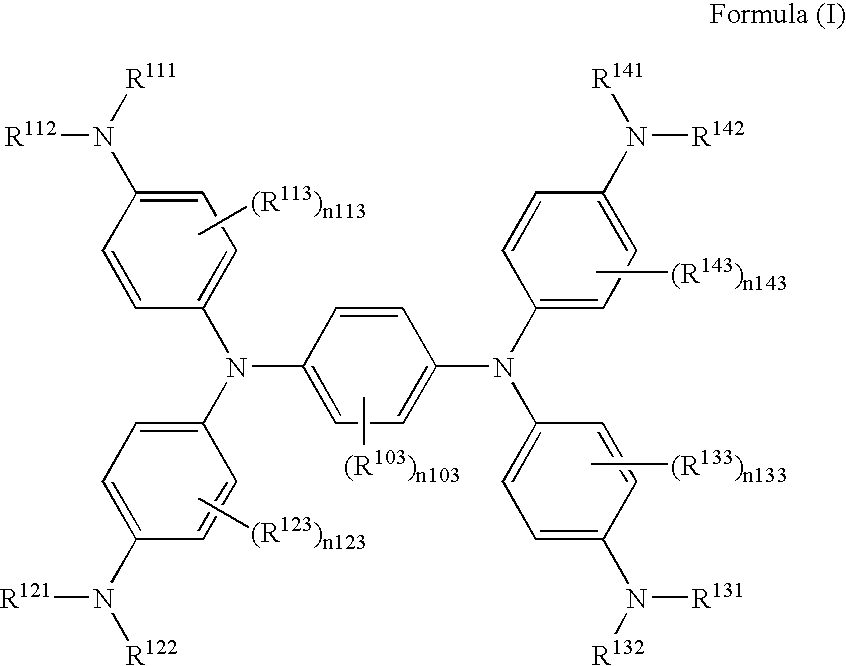Method of producing near-infrared absorbing dye compound
a dye compound and near-infrared technology, applied in the preparation of isocyanic acid derivatives, organic chemistry, record carrier materials, etc., can solve the problems of large environmental load, high cost, and unsatisfactory methods in yield
- Summary
- Abstract
- Description
- Claims
- Application Information
AI Technical Summary
Benefits of technology
Problems solved by technology
Method used
Image
Examples
reference example 1
Synthesis of Exemplified Compound (I-10)
[0037]According to the following scheme, Exemplified compound (I-10) was synthesized.
Synthesis of a Compound 2
[0038]A three-neck flask was charged with 56.5 g of p-phenylenediamine, 495 g of p-nitrochlorobenzene (1), 173.7 g of potassium carbonate, 750 ml of 1-methyl-2-pyrrolidone and 10 g of a copper powder and the mixture was stirred under heating and refluxing for 70 hours as it was. The reaction mixture was cooled to ambient temperature to obtain crystals, which were then washed with 1-methyl-2-pyrrolidone, washed with water and then dried by air, to obtain 297.3 g of the target compound 2 (yield: 96%). The mass-spectrum of this compound was measured, to find that M=592. Melting point: 300° C. or more.
Synthesis of a Compound 3
[0039]A three-neck flask was charged with 160 g of the compound 2, a solution containing 0.32 g of iron (III) chloride and 160 ml of isopropyl alcohol, 8.1 g of activated carbon and 1340 ml of 1-methyl-2-pyrrolidone a...
example 1
Synthesis of the Exemplified Compound (II-3)
[0041]The exemplified compound (II-3) was synthesized according to the following scheme.
[0042]In a three-neck flask, 9.21 g of the exemplified (I-10) was dissolved in 120 ml of ethyl acetate, to which was then added 40 ml of acetonitrile and the mixture was stirred at ambient temperature. An aqueous solution prepared by dissolving 12.3 g of OXONE (trade name, commercially available from Sigma-Aldrich-Japan, having a composition of 2 KHSO5.KHSO4.K2SO4) manufactured by Du Pont and 2.44 g of sodium perchlorate in 40 ml of water was added dropwise to the mixture for 30 minutes, which was then stirred for 3 hours as it was. The resulting solution was fractionated and washed with a mixture solution of 60 ml of water and 10 ml of saturated brine three times. Then, the resulting mixture was concentrated by a rotary evaporator, ethyl acetate was added to the obtained residue and the obtained crystals were subjected to filtration and drying to obtai...
example 2
Synthesis of the Exemplified Compound (II-3)
[0043]The exemplified compound (II-3) was synthesized according to the following scheme.
[0044]In a three-neck flask, 9.21 g of the exemplified (1-10) was dissolved in 120 ml of ethyl acetate, to which was then added 40 ml of acetonitrile and the mixture was stirred at ambient temperature. An aqueous solution prepared by dissolving 12.3 g of OXONE (trade name, commercially available from Sigma-Aldrich-Japan, having a composition of 2 KHSO5.KHSO4.K2SO4) manufactured by Du Pont and 2.77 g of potassium perchlorate in 40 ml of water was added dropwise to the mixture for 30 minutes, which was then stirred for 3 hours as it was. The resulting solution was fractionated and washed with a mixture solution of 60 ml of water and 10 ml of saturated brine three times. Then, the resulting mixture was concentrated by a rotary evaporator, ethyl acetate was added to the obtained residue and the obtained crystals were subjected to filtration and drying to ob...
PUM
| Property | Measurement | Unit |
|---|---|---|
| temperature | aaaaa | aaaaa |
| temperature | aaaaa | aaaaa |
| temperature | aaaaa | aaaaa |
Abstract
Description
Claims
Application Information
 Login to View More
Login to View More - R&D
- Intellectual Property
- Life Sciences
- Materials
- Tech Scout
- Unparalleled Data Quality
- Higher Quality Content
- 60% Fewer Hallucinations
Browse by: Latest US Patents, China's latest patents, Technical Efficacy Thesaurus, Application Domain, Technology Topic, Popular Technical Reports.
© 2025 PatSnap. All rights reserved.Legal|Privacy policy|Modern Slavery Act Transparency Statement|Sitemap|About US| Contact US: help@patsnap.com



